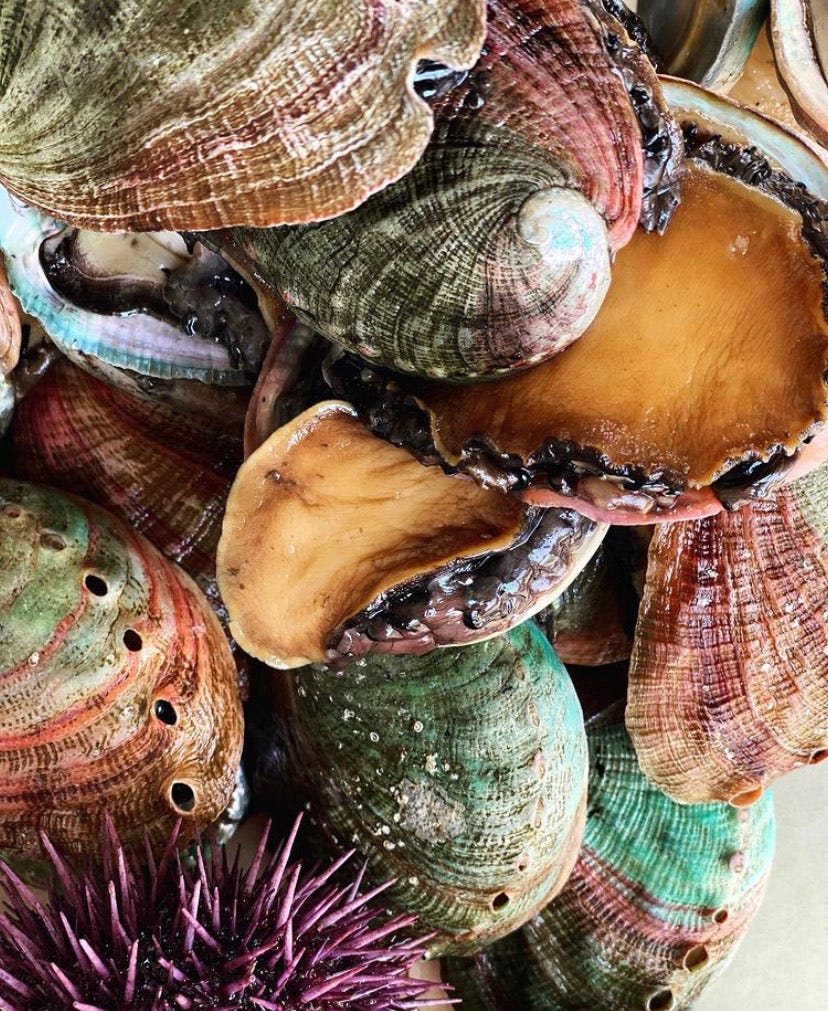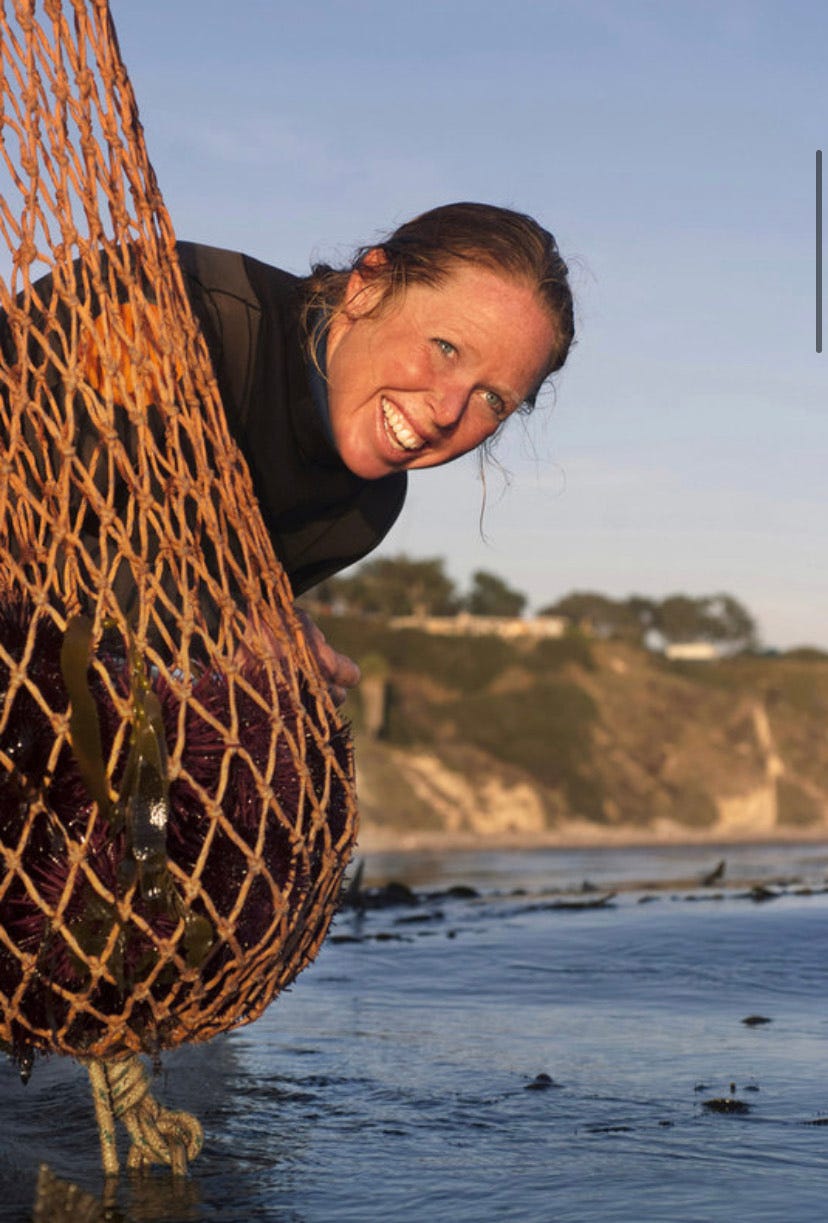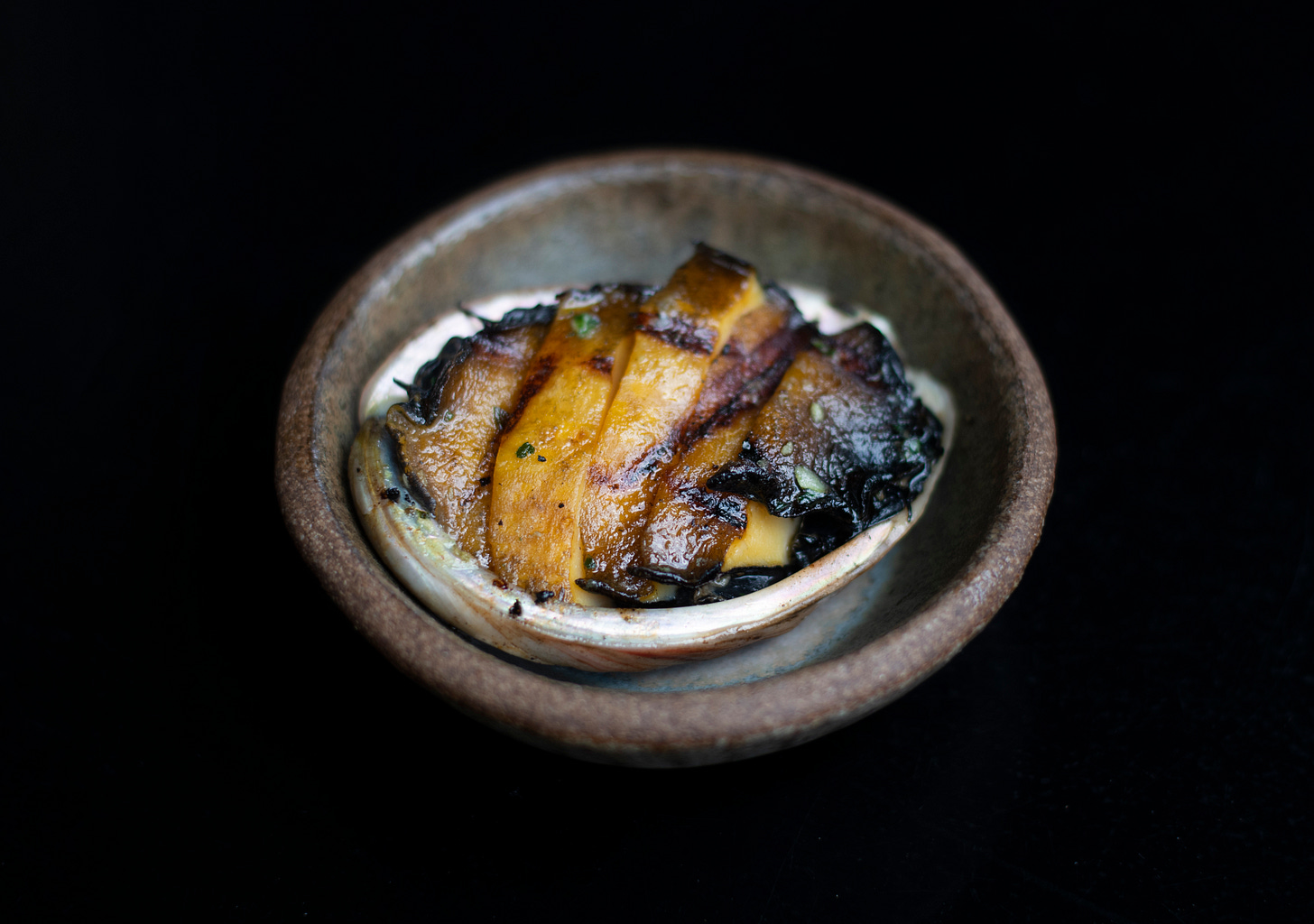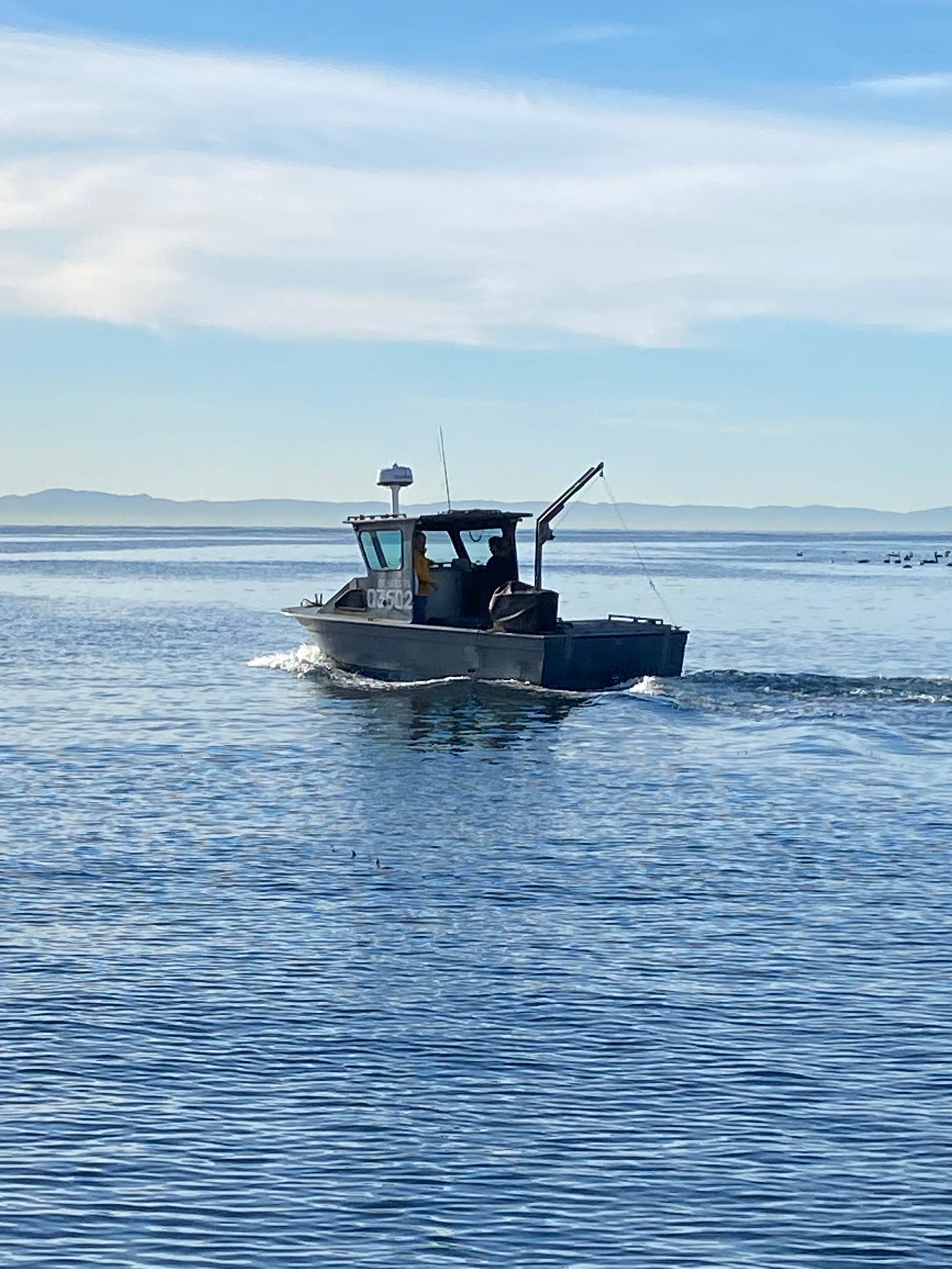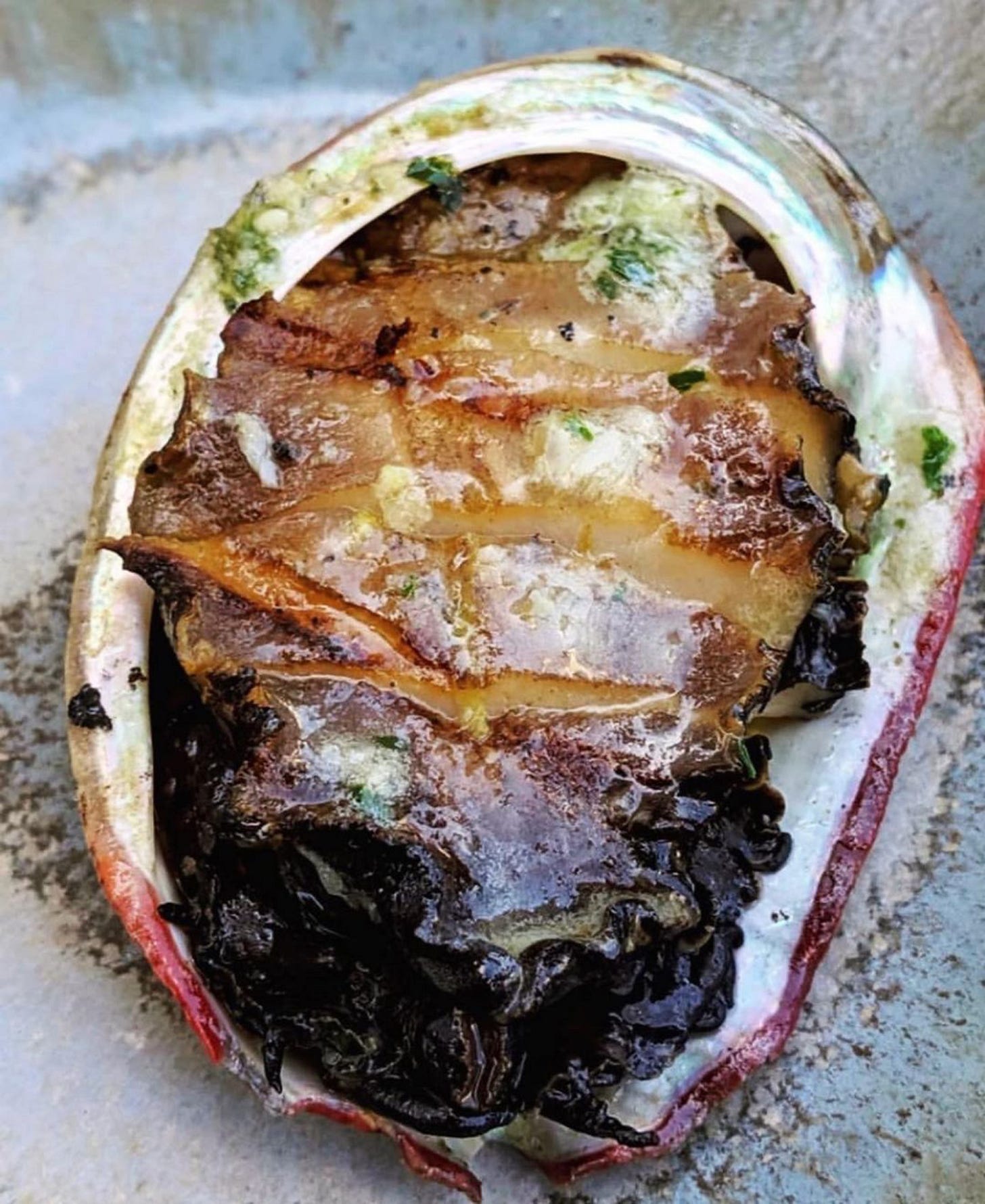Welcome to Issue Two! Thank you so much to everyone for your warm reception for the California Table. I’m so thrilled to know that so many people are as excited about the state’s many, varied foodways as I am. If you missed the first issue—Lorraine Hee-Chorley’s story of how her great-grandfather sailed from China (and her amazing turkey congee recipe)—you can find it here.
This week we’re traveling way down the coast for a very different kind of story. A few months ago, I had the great pleasure of speaking with Stephanie Mutz, a sea urchin diver and the owner (with her business partner, Harry Liquornik) of Sea Stephanie Fish. Stephanie told me about growing up catching and eating seafood with her friends, how she got into the “mermaid” business, and how she and Harry banded together with other area fishermen during the height of the pandemic restrictions to market their seafood directly to consumers. She also shared an absolutely fantastic abalone recipe that I highly recommend as a holiday appetizer. (There’s info below, with the recipe, about how residents of LA, the Central Coast, and the Bay Area can order their seafood in time for the holidays.)
Here are my conversations with Stephanie, edited and condensed for clarity:
Stephanie Mutz
I grew up in Newport Beach, but I’ve been in Santa Barbara most of my life. So the ocean and underwater is really all I’ve ever known. I was a marine biologist and a researcher, and I wanted to continue that, and I wanted to be a professor—and I am one, very part time.
The way I got into diving for sea urchin is that I was teaching part time, deck-handing part time, bartending part time, and doing fisheries policy. During the last financial crisis, I got laid off from my teaching job. So I thought, Let’s try this fishing thing and see how it works. And it did.
I was a research diver, so I knew how to dive and the politics of it all. And it just happened that the first job I got on a commercial boat was on a sea urchin boat. It was just kind of serendipitous. It’s kind of funny; when I was an undergrad, my senior thesis project was on the food preferences of sea urchins—having no idea that I would be an urchin diver. I like to say it chose me; I didn’t necessarily choose it.
Three years ago, I saw a need to figure out how to make money by controlling the purple urchin populations. They’re not invasive, they’re just being a nuisance at the moment, because their predator went away. All the sea stars went away in 2015 with El Niño. They all had a virus of some sort that was related to the warm water, I think. I don’t have all the information on it. A lot of the sea stars have come back, but not the Pycnopodia, the sunflower star, which is one of the main predators of the purple urchins and kept their populations in check.
So all these other fishermen and divers were complaining about how many there. They wanted to try to get grants, and there were people volunteering to catch them and just smash them. I don’t have time to just go and smash them. It didn’t feel like I would get my return on my investment if I did that. But if I can make a living off it….
So we just tried it. We collected purple urchins in the wild, and then we take them to the abalone farm— Cultured Abalone Farm on Dos Pueblos Ranch—to finish them off. Because they're not marketable; they're empty inside. They’re healthy and well, but there’s nothing to eat inside if they’re in the wild, because there's too many of them. So we collect them in the wild and then take them to the farm and feed them. We fatten them up for a few weeks, and then they're creamy and sweet and delicious. It was a collaborative effort between Doug Bush [who owns the farm] and Harry and I, trying to figure out what to feed them. It took about a year until we dialed into the program that we have now. And we’re still learning.
Before the pandemic, we were primarily selling to restaurants, mostly white tablecloth restaurants or Michelin star restaurants. N/naka, Providence, Connie and Ted’s—a lot of LA and Santa Barbara restaurants. Farallon [which closed in 2020] and the Morris were our main ones in the Bay Area.
We transitioned to retail the hard way. The first two weeks, our learning curve was quite steep and all about what not to do. At first we were just taking text message orders and putting them into an Excel spreadsheet, and that was hell on earth. Then we transitioned to an online store, and that works a lot better.
We were already dabbling in retail a little bit, so it wasn't like it was completely foreign to us. The model we do now is based on these little pop-ups we did in San Francisco once in a while, before Covid. That was mostly just for me to get the heck out of town—an excuse to go play in San Francisco with my uncle and some friends up there.
With Covid, restaurants literally closed overnight, and we had all this sea urchin holding. We know how to hold them for a week, but that’s it. So we needed to unload all of this seafood without it going to waste.
We learned a lot. We could have taken two strategies: There's the strategy of backing off and planning and strategizing, or there's just jumping in with two feet. And we had all this live seafood. That’s the reason why we initially were going to direct to consumer. I mean, it's a lot of work, but we like it that we know that our seafood is not being wasted. It's being appreciated.
And we liked the community aspect of it a lot. It gives more purpose to being a fisherman. Like, any monkey can go get an urchin. But to get the good quality ones and to be able to get the response back from customers who get so excited about what you're offering to them—especially in a pandemic, especially when everyone's so stressed out and all they want is, like, treats, and to feel normal, and you get to provide that—that return right there was huge. And it still is.
Because of Covid, and a lot of restaurants shutting down, initially a lot of fishermen lost their markets too. So there's been a few of us who have stepped up our retail game. Some fishermen weren't even in retail before, and they started retail. At first I was like, Aw, shoot—more competition, but then we each found our niches with our markets and started selling each other the products that we catch.
We also collaborate. Like, we had king salmon on the menu, but we had to go to Bodega Bay, which is an eight-hour drive, to go get the fish. Instead of each of us going up there every week, we would take turns and bring thousands of pounds back and then distribute it among the other fishermen who would sell it. So we were able to buy whole boats’ worth of fish. A lot of these other, more traditional fish markets were trying to lower the price, but we wanted the product, so we would offer more money. We know what it takes to fish. We know what the fair price is. So we're going to offer the fair price.
Part of our efforts, doing this direct marketing, is to catch less, still make a living, and look out for the longevity of this resource. Harry and I are still relatively young. And it would be rad if the next generation could have this. It’s part of our business plan, and it’s really important. We’re really particular in how we’re harvesting and how we’re taking care of this resource. It’s a priority.
When I was growing up, if we needed some seafood, we just got it out of the ocean. And my parents weren’t fishermen, it was just something I did with my friends. We’d get lobster, fish, crabs—mostly stuff that can’t move very fast. Friends would know how to steam them, lifeguards and stuff would know how to cook them. It’s just what you did; you just rode your bike to the beach to play with your friends all day and know to be back when the streetlights went on.
I’m more creative now than when I was younger. When I first started diving, a lot of the energy was focused on what the heck I’m doing and how to find the good quality urchin, and then it went to Ok, this is a sea urchin, it tastes really good, but what else can we pair it with? What other textures? What other flavors? I’m constantly having these discussions. Not just about wine or beverages but about other foods. And that never gets old to me.
The other part of it is making seafood approachable to make at home. I’m trying to teach people how easy it is to prepare their seafood. It doesn’t have to be an all-day affair. You don’t have to get too fancy.
My very favorite way to eat urchin is straight out of the shell; just cut it open, clean it, and add a little sea salt. With spiny lobster, I just like to barbecue them. But you can even just microwave them for four minutes, and it’s delicious. I get made fun of all the time—people are like, “You’re not really going to do that, are you?” And I’m like, “Just try it! It’s easy!”
The whelks are a little bit more labor intensive, but their flavor profile is like nothing else. I like to fry them like popcorn shrimp-ish type things. You have to kill them by either freezing them or boiling them, because you’ll lose that battle if you try to pull them out of their shell while they’re alive. They will win. I fry them with flour and panko. You know how with popcorn shrimp, the actual shrimp is probably farmed in Thailand and Vietnam, and it’s pretty flavorless? Imagine having that fried goodness with actual sweet, umami flavors. It’s a pretty great treat.
I do abalone “Mermaid Style” on a hot, hot, hot grill. It’s called “mermaid style” because I made it up and I’m an urchin diver. The people at the abalone farm made it up.
At Christmas I eat leftovers—whatever I can’t sell. Lobster and abalone and sea urchin are go-tos. Sea urchin is a snack I eat way too much of, eating my profits. I might have some fish frozen. Fish sales tend to slow down in winter, so I usually have some. There’s an Italian tradition of doing cioppinos and putting in whatever fish you have, and I tend to do a cioppino at Christmas. It’s whatever’s leftover. There’s lobster, there’s crab, there’s mussels, there’s shrimp; I’ll even throw some urchin on top. We make a stock with fish bones and crustacean shells and I’ll probably put some chunks of frozen salmon in there. Anything that’s leftover from market and from the freezer. That is the whole purpose of a cioppino, where everyone chips in their leftovers and make it into a stew. I’m not huge on a very tomatoey sauce, but I do like tomatoes in there, maybe a little bit of olive juice, and then I make my broth with produce from the garden. Serve it with sourdough bread.
Recipe: Abalone Mermaid Style
Here is Stephanie’s recipe for grilled abalone, in her own words. This isn’t as much a recipe as a method for cooking them, but I can tell you from experience that they’re easy and really, really delicious. (They make an absolutely fantastic start to a holiday meal.)
The abalone that Stephanie cooks are the small ones raised by Doug Bush at Cultured Abalone Farm on Dos Pueblos Ranch. They’re far more tender than the big ones fishermen used to find off the coast, which needed to be tenderized and pounded before being cooked. If you’re planning to serve these as appetizers, you’ll want one abalone per person.
Small, 3”-4” long abalone
Minced garlic
Butter
Salt
Get your grill—or your oven—at 450°, 500° even. Be generous with the garlic and butter and the salt on the abalone. Put the abalone on the grill shell down for 4 to 5 minutes, tops, then turn it over, shell up, for about a minute to caramelize the meat. And if it just slides off, you’ve nailed it. I like to cut it in slices. You can eat the whole thing—the guts and everything—cause all they’re eating is kelp. And it’s delicious.
To order abalone, urchin, crab, and other seafood from Stephanie and her partners, visit SeaStephanieFish.com. Their holiday ordering and pickup schedule is up now.
More California Stories to Read, Watch, and Listen To
As part of their package on Chez Panisse’s 50th anniversary, the San Francisco Chronicle has some great articles about the restaurant’s history and its impact on California dining, including six of the restaurant’s classic recipes. On her most recent Good Food podcast, Evan Kleiman covered one of my favorite fruits: persimmons. And the PRX radio show The World did a fascinating piece last week about America’s first Koreatown, in Riverside, CA.
Lastly, if you haven’t done so already, run out and buy a copy of the beautiful book New Native Kitchen, which has a section about the history and foods of the Chumash people of California’s Central Coast. (Even better, order it from Now Serving in Los Angeles or Omnivore Books in San Francisco.)
Photos courtesy of Stephanie Mutz and the team at the Morris, in San Francisco, where Stephanie has one of her pickup spots. The chefs at the Morris prepare her seafood regularly, and it’s a great place to try urchin, abalone, and other goods if you’re nervous about cooking them at home for yourself.




